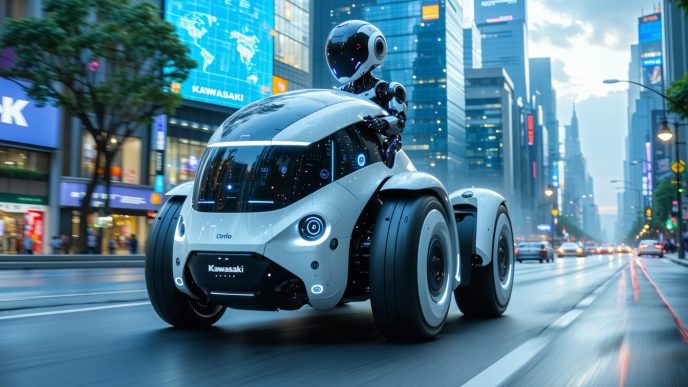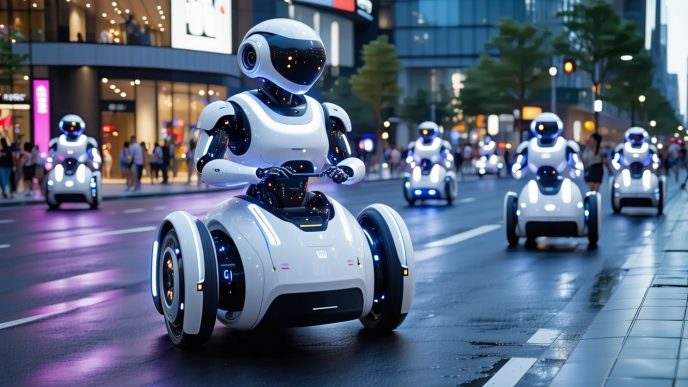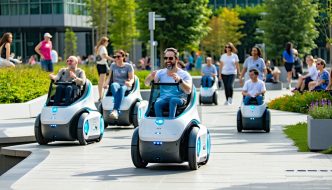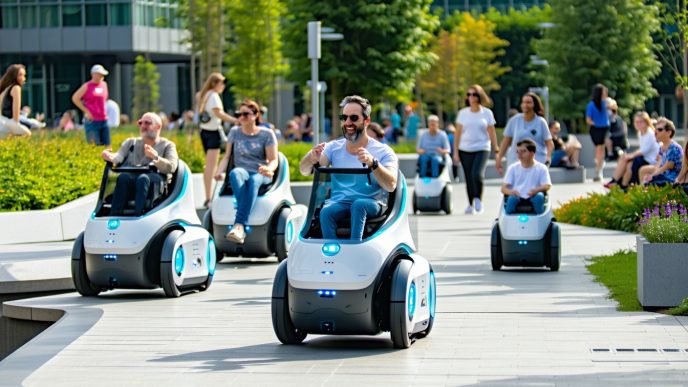Rideable AI: A Revolutionary Mobility Solution
Rideable robots are at the forefront of transforming personal and commercial mobility solutions. These robots provide innovative ways to traverse environments, whether for commuting, recreation, or task-oriented activities. As technology continues to advance, the integration of rideable AI is revolutionizing how individuals and businesses approach transportation.
The Evolution of Rideable Robots
The development of rideable robots has taken significant strides from early prototypes to today’s advanced models. Initially, concepts were rudimentary, focusing primarily on basic mobility functions. However, continuous improvements in technology have led to the creation of sophisticated systems that can navigate a variety of terrains and adapt to user needs.
Innovations in sensors, artificial intelligence, and robotics have propelled the evolution of rideable robots. Professionals and business owners now have access to an array of rideable solutions, including electric scooters and self-balancing hoverboards. Understanding the progress of these technologies allows users to make informed choices for mobility solutions suited to their requirements.
Importance of Battery Life in Rideable Robots
The battery life of rideable robots is crucial for their efficiency and usability. As these mobility devices rely on electric power, their operational range and effectiveness directly hinge on battery performance. A longer-lasting battery ensures users can travel greater distances without interruptions, making rideable robots more practical for daily use.
Factors impacting battery life include the weight capacity of the rideable robot, terrain type, and speed settings. Understanding these factors helps users optimize the performance of their machines. Below is a comparison of the average battery life across different types of rideable robots:
| Type of Rideable Robot | Average Battery Life (Hours) | Average Range (Miles) |
|---|---|---|
| Electric Skateboards | 1 – 3 | 5 – 15 |
| Electric Scooters | 2 – 4 | 10 – 30 |
| Self-Balancing Hoverboards | 1 – 3 | 6 – 12 |
Given the importance of battery life, professionals and tech-forward homeowners must consider their specific needs when selecting rideable robots. Battery efficiency plays a pivotal role in maximizing their potential and aligns with active and convenient lifestyles. For further insights on rideable technology, check out our coverage on rideable robots and specific models like the kawasaki corleo robot or xiaomi cyberdog 2 rideable concept.
Understanding Battery Life in Rideable Robots
The battery life of rideable robots is crucial for their functionality and user satisfaction. Understanding the variables that affect battery longevity can help professionals and tech-forward homeowners make informed decisions about their use.
Factors Affecting Battery Life
Several factors can determine how long a rideable robot operates before needing a recharge. Key considerations include:
| Factor | Description |
|---|---|
| Weight | Heavier robots typically consume more energy, leading to shorter battery life. |
| Terrain | Riding on inclines or uneven surfaces demands more power, reducing overall battery duration. |
| Speed and Usage | Faster travel speeds consume power more quickly, leading to increased battery depletion. |
| Weather Conditions | Extreme temperatures can affect battery performance, with cold weather generally causing reduced efficiency. |
| Maintenance | Regular maintenance of the robot and its components can help optimize battery life. |
How Battery Technology Impacts Rideable Robots
Battery technology plays a significant role in the performance of rideable robots. The type and quality of the battery can influence how long the robots can operate and their efficiency in various conditions.
| Battery Type | Characteristics |
|---|---|
| Lithium-ion | Commonly used due to high energy density, long life cycle, and lighter weight. |
| Lead-acid | Generally heavier and less efficient but cost-effective for some applications. |
| Nickel-metal Hydride | Offers good performance but has a shorter lifespan compared to lithium-ion batteries. |
Advancements in battery technology continue to enhance the capabilities of rideable robots. Innovations in lithium-ion batteries, for instance, allow for quicker charging times and longer life spans, leading to improved efficiency and utility in real-world applications. For more insights, explore our article on rideable robots to see how these technologies are shaping the future of mobility.
Battery Life Comparison
When assessing the battery life of rideable robots, it’s crucial to consider various categories of devices, including electric skateboards, electric scooters, and self-balancing hoverboards. Each type has its own unique characteristics and performance benchmarks, influencing its overall battery performance.
Electric Skateboards
Electric skateboards have gained popularity as an innovative mode of transport. Their battery life is often a key factor for users, especially those using them for commuting or recreational purposes. The average battery runtime varies based on speed, weight capacity, and terrain.
| Feature | Average Range (miles) | Average Charging Time (hours) | Battery Capacity (Wh) |
|---|---|---|---|
| Standard Electric Skateboard | 7 – 12 | 2 – 4 | 200 – 500 |
Electric Scooters
Electric scooters provide an efficient means of urban transport. They are generally designed for convenience and portability, and their battery life reflects their intended use. Users can expect various ranges depending on the scooter’s design and power.
| Feature | Average Range (miles) | Average Charging Time (hours) | Battery Capacity (Wh) |
|---|---|---|---|
| Standard Electric Scooter | 15 – 25 | 4 – 6 | 250 – 800 |
Self-Balancing Hoverboards
Self-balancing hoverboards have unique balance technology requiring a specific design that impacts their battery life. Users appreciate their fun factor, but usability can vary significantly based on riding conditions.
| Feature | Average Range (miles) | Average Charging Time (hours) | Battery Capacity (Wh) |
|---|---|---|---|
| Self-Balancing Hoverboard | 6 – 12 | 2 – 3 | 100 – 300 |
The comparison of battery life across these rideable robots indicates that while each type has its strengths, understanding their limitations can help professionals, business owners, and tech-forward homeowners choose the right solution for their needs. For a deeper exploration of rideable robots, visit our article on rideable robots.
Maximizing Battery Life
The battery life of rideable robots is a critical factor for their performance and usability. Extending the operational time between charges is essential for users seeking efficiency and convenience. Here are some practical tips for maximizing battery life and proper charging practices.
Tips for Extending Rideable Robot Battery Life
Several strategies can enhance the longevity of a rideable robot’s battery. Implementing these practices can lead to improved overall performance and longer usage times.
| Tip | Description |
|---|---|
| Avoid Deep Discharge | Regularly charging the battery before it is completely drained helps preserve its lifespan. Aim to recharge when the battery level drops below 20%. |
| Maintain Optimal Temperature | Store and use the robot within recommended temperature ranges to avoid overheating or excessive cold that can degrade battery performance. |
| Limit High Speeds | Riding at moderate speeds rather than maxing out the throttle can significantly conserve battery power. |
| Regular Maintenance | Ensuring that all mechanical parts are functioning properly helps to reduce strain on the battery. |
| Use GPS Sparingly | If equipped with GPS, limit its use when unnecessary, as this can drain the battery significantly. |
Proper Charging Practices
Charging methods and habits play a vital role in preserving battery health. Following recommended charging practices can optimize battery life and performance.
| Charging Practice | Description |
|---|---|
| Use the Right Charger | Always use the charger specified by the manufacturer to prevent overheating or damaging the battery. |
| Charge After Each Use | Whenever possible, charge the battery after each use, rather than waiting until it is nearly empty. |
| Avoid Overcharging | Unplug the battery once it reaches full charge to prevent excessive voltage that can shorten lifespan. |
| Charge at Room Temperature | Allow the battery to charge at room temperature, avoiding extreme cold or heat during the charging process. |
Implementing these practices can significantly impact the battery performance of rideable robots. Interested readers can explore more about rideable robots and their various applications in both commercial and residential settings.
Innovations in Battery Technology
The battery life of rideable robots is a critical aspect of their functionality and usability. Innovations in battery technology play a significant role in enhancing the performance of these mobility solutions.
Advances in Lithium-ion Batteries
Lithium-ion batteries have become the standard choice for rideable robots due to their high energy density, lightweight nature, and efficiency. Recent advances in lithium-ion technology have led to significant improvements in battery life, charging speed, and overall performance.
| Feature | Traditional Lithium-ion Batteries | Advanced Lithium-ion Batteries |
|---|---|---|
| Energy Density (Wh/kg) | 150-200 | 250-300 |
| Charging Time (hrs) | 3-5 | 1-2 |
| Lifespan (cycles) | 500-1000 | 1500-2000 |
| Temperature Range (°C) | -20 to 60 | -30 to 70 |
New formulations and design enhancements, such as the use of silicon anodes and solid-state electrolytes, have contributed to these advancements. These improvements not only extend the battery life of rideable robots but also enhance their safety by reducing the risk of overheating.
Potential Future Battery Technologies
Looking ahead, several emerging battery technologies hold the promise of further revolutionizing the battery life of rideable robots. These include:
-
Solid-state Batteries: These batteries replace the liquid electrolytes found in traditional lithium-ion batteries with solid materials, improving energy density and safety while reducing charging times.
-
Sodium-ion Batteries: Utilizing sodium instead of lithium can lead to a more sustainable and cost-effective alternative, albeit currently with lower energy density. Research is ongoing to enhance their performance.
-
Graphene Batteries: Graphene’s exceptional conductivity and strength could lead to batteries that charge faster, last longer, and have a lighter weight. Research in this area is showing promising results but is still in the early stages.
-
Fuel Cells: Hydrogen fuel cells offer an alternative that could provide longer runtimes compared to conventional batteries, suitable for rideable robots that require extended use without frequent charging.
Exploring these future battery technologies can potentially transform the mobility landscape, making rideable robots even more efficient and practical for everyday use. For more insights into specific implementations of rideable robots, check our articles on rideable robots and rideable robots for disabled mobility.
Real-world Applications
Rideable robots are increasingly being integrated into various sectors, showcasing their versatility and practicality. Both commercial and residential applications leverage these innovative mobility solutions.
Commercial Uses of Rideable Robots
In commercial settings, rideable robots offer efficient solutions for transportation and logistics. Businesses utilize these robots to enhance operational efficiency and productivity. A few notable applications include:
| Application | Description |
|---|---|
| Delivery Services | Rideable robots can transport goods over short distances, optimizing delivery times in urban environments. |
| Warehouse Operations | Robots assist in moving products within large warehouses, reducing the need for manual labor and increasing speed. |
| Emergency Services | Some organizations employ rideable robots for quick response in emergency situations, offering immediate transportation and support. |
| Marketing and Promotion | Companies use rideable robots in promotional events to attract customer attention and engage with audiences. |
For detailed insights into specific models and types, including the kawasaki corleo robot and the xiaomi cyberdog 2 rideable concept, further exploration can be beneficial.
Residential Applications of Rideable Robots
In residential environments, rideable robots enhance daily living by providing convenient mobility solutions. Homeowners can benefit from applications such as:
| Application | Description |
|---|---|
| Personal Transport | Individuals with mobility issues can use rideable robots, promoting independence and mobility in their daily activities. |
| Recreational Use | Families utilize rideable robots for recreational activities, such as leisurely rides in parks or neighborhoods. |
| Assistance for Disabled Individuals | These robots offer specialized options designed to aid those with disabilities, improving their access to various environments. |
| Garden and Yard Maintenance | Some robots are designed to assist in outdoor tasks, such as transporting gardening supplies or monitoring yard conditions. |
For a focus on assistive technology, consider investigating the impact of rideable robots for disabled mobility.
As rideable robots continue to evolve, their applications in commercial and residential settings serve as a testament to their practicality and effectiveness. Understanding the battery life of rideable robots is crucial for optimizing their performance across these varied uses.
Challenges and Considerations
As rideable robots gain popularity, professionals and business owners must consider the inherent challenges associated with their battery life. The following sections explore the trade-offs between performance and battery longevity, as well as the environmental impact of these advanced mobility solutions.
Performance vs. Battery Life Trade-offs
When evaluating rideable robots, one of the primary considerations is the delicate balance between performance and battery life. Higher performance levels often require more power, leading to a reduction in operational time between charges. For instance, faster speeds, increased load capacities, and sophisticated features consume more energy, which can significantly shorten the battery lifespan.
Here’s a comparison of different rideable robots, examining their performance parameters against battery longevity:
| Robot Type | Speed (mph) | Range (miles) | Average Battery Life (hours) |
|---|---|---|---|
| Electric Skateboard | 20 | 15 | 2 – 4 |
| Electric Scooter | 15 | 20 | 3 – 5 |
| Self-Balancing Hoverboard | 10 | 5 | 1 – 3 |
As shown in the table, electric scooters tend to offer a better balance of speed and range compared to electric skateboards and hoverboards. Understanding these dynamics allows users to make informed decisions based on their mobility needs.
Environmental Impact and Sustainability
The environmental implications of rideable robots and their batteries warrant careful consideration. The production, disposal, and recycling of batteries can have significant consequences for our ecosystem. As battery technology evolves, there is a pressing need for more sustainable practices to mitigate these effects.
Lithium-ion batteries, commonly used in rideable robots, have raised concerns regarding their environmental footprint. These batteries contribute to resource extraction, environmental degradation, and toxic waste if not disposed of properly.
To address sustainability, some manufacturers are exploring eco-friendly alternatives or recycling programs for old batteries. Supporting advancements in battery technology, including studies on biodegradable options, is essential for the overall environmental impact of rideable robots.
For further insights into the applications and benefits of rideable robots, refer to our articles on rideable robots for disabled mobility and rideable quadrupeds vs scooters. As the field of rideable robots continues to develop, balancing performance with sustainability will be critical for future innovations.















